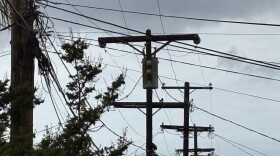Within four months of being of one of eight cities in the country to test the smart phone app LevelUp, 85 San Diego businesses are using it.
In San Francisco, the only other California test market, nearly 200 merchants currently use the device.
It works like this.
A pay dock, called a “tap-and-pay pad” sits next to the cash register. When customers are ready to pay, they simple tap their phone on the pad.
In less time then it takes to open the cash register, the customer has paid with a direct charge to their credit card. Seconds later, a receipt shows up on their phone.
Before the first use, it’ll take a couple of minutes to download the free app, register security information and scan your credit card of choice.
From then on, you’ll be able pay from this electronic wallet in three seconds flat.
“When you pay with LevelUp and your phone, the business saves a bunch of money and they use those savings to reward the customer,” said Priebatsch.
Typically, credit card companies charge merchants a swipe-fee each time a customer pays with credit. There’s also a business a transaction fee of up to 5 percent based on the amount of the sale.
With LevelUp, there’s no swipe fee and the sales transaction fee is a flat rate of 2 percent.
“We’re working on trending down our transaction fee to 1 percent or less,” said Priebatsch.
He believes, the $25 monthly fee for operating the pay-pad device will be enough revenue.
Bill Olsker, owner of The Works restaurant in Mission Valley has used the device since its introduction to San Diego in February.
“It’s beneficial to me because it builds loyalty with my customers. I get a lot of repeat business,” said Olsker.
He said new and return business is a benefit of the app's discounts and cash rewards.
“I just signed up today, it paid $5 toward my meal, so I only paid $3 for my lunch,” said Dan Simpson, a new LevelUp convert.
He’s part of growing population that prefers e-money to traditional payment options.
A recent Pew survey found 65 percent of Internet users polled in the U.S., said they would use a smart- swiping device instead of cash or credit cards.
However, there is a reoccurring concern over security.
But, Priebatsch insists LevelUp is safer than credit cards and cash.
“With LevelUp by default you’re linking your credit card, so you start with all the protections of your credit card. You can also can pin-lock it. You can’t pin lock your leather wallet,” he explained.
He’s not the first to market the security and convenience of mobile money.
Starbucks has the most mobile pay devices in the county, but its app only works at Starbucks.
Approximately 140,000 merchants nationwide use Google Wallet. But, Google requires exclusive use of Citibank’s MasterCard, or Google’s pre-paid card and it only works on the Nexus S4G phone.
LevelUp only works on iPhones and Androids. Since its February launch, 2,500 merchants nationwide use its app.
But, Priebatsch wants more than market domination. His lofty goal is to alter the national economy by eliminating credit card processing fees altogether.
“Payment credit card processing fees in 2011 where $50 billion—that’s $50 billion out of business and consumers pockets,” he explained.
Financial institutions aren’t going to give up that kind of profit, said David Ely, Ph.D., a finance professor at San Diego State University.
“The will seek other sources of revenue, higher fees or charges elsewhere in the business to make up for any revenue that they loose from transaction fees,” Ely said.
Hundreds of billions of dollars are at stake worldwide.
A recent survey by Juniper Research found the global market for mobile payments is projected to nearly triple in value from $240 billion this year to $670 billion by 2015.
But monetary success is not guaranteed.
From the first documented barter system in 9,000 BC to today’s mobile money change has come from the hands of the buyer, not the seller.
And if e-money feels a bit to Orwellian right now, just remember it took years for ATMs to catch on.






